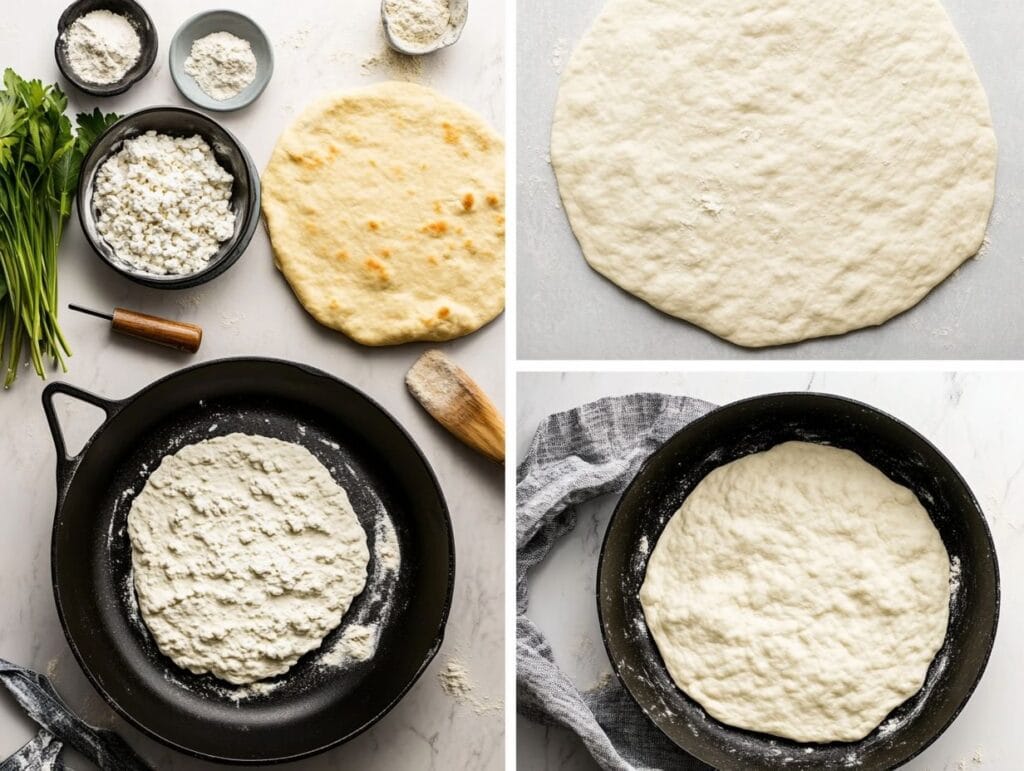Last updated on: February 11, 2025
Table of Contents
In the vast world of flatbreads, where naan, pita, and focaccia reign supreme, cottage cheese flatbread offers a refreshing twist. It merges the mild, creamy texture of cottage cheese with the crisp, comforting base of a traditional flatbread. This culinary creation not only tantalizes your taste buds but also introduces an extra punch of protein to your meals.
Cottage cheese flatbread serves as a versatile base for a plethora of toppings—from classic herbs to avant-garde combinations, it can be tailored to suit any palate, making it a favorite for meal planners and creative cooks alike.
- “While exploring various unique breakfast recipes like our cottage cheese flatbread, don’t miss out on trying our easy-to-make Mini Pancakes, perfect for a quick and delightful morning treat.”
What is Cottage Cheese Flatbread?
Cottage cheese flatbread is essentially a soft, leavened bread that incorporates cottage cheese into its dough. Unlike denser flatbreads, the addition of cottage cheese gives this bread a soft texture and a deliciously tangy flavor that complements both sweet and savory dishes. It’s perfect as a side to your main course, as a base for pizza-style toppings, or simply enjoyed on its own, brushed with a bit of olive oil and a sprinkle of sea salt.
Why Choose Cottage Cheese for Your Flatbread?
Choosing cottage cheese as a key ingredient in flatbread dough brings numerous benefits. It increases the protein content, making the bread more filling and nutritious. Additionally, cottage cheese helps to moisten the dough, which results in a softer, fluffier bread without the need for extra fats or oils. It’s an ideal choice for those looking to enhance their diet without sacrificing flavor or texture.
- “Curious about what makes pancakes fluffy in restaurants? Discover the secrets behind perfect pancakes and see how you can apply similar techniques to enhance your flatbread in our detailed guide, Why Restaurant Pancakes Are So Fluffy: Secrets to Perfect Pancakes.”
Nutritional Benefits of Cottage Cheese Flatbread
Incorporating cottage cheese into your flatbread not only enhances its flavor and texture but also boosts its nutritional profile. Cottage cheese is low in fat but high in protein, which can help keep you fuller for longer—a plus for anyone watching their weight or looking to increase their protein intake.
Key Nutrients in Cottage Cheese
“Cottage cheese is a powerhouse of essential nutrients. It is packed with protein, rich in calcium, and a good source of essential vitamins such as B12, which plays a crucial role in brain health and metabolism,” explains a nutrition expert.
Cottage cheese also contains a significant amount of phosphorus, a mineral that’s essential for the formation of bones and teeth, as well as the repair, maintenance, and growth of all tissues and cells.
Health Benefits of Cottage Cheese in Baking
Using cottage cheese in baking offers more than just a delightful taste. It contributes to heart health by maintaining lower levels of unhealthy fats and cholesterol compared to more traditional baking ingredients like butter or cream. Its high protein content also aids in muscle repair and growth, making cottage cheese flatbread a great post-workout snack.

Classic Cottage Cheese Flatbread Recipe
To kickstart your journey with cottage cheese flatbread, here’s a simple yet delightful recipe that you can make at home. This basic recipe sets a perfect foundation that’s ripe for customization with your favorite flavors and toppings.
Ingredients List
- 2 cups all-purpose flour (or whole wheat flour for a healthier option)
- 1/2 cup warm water
- 1 cup cottage cheese
- 1 teaspoon sugar
- 1 packet instant yeast (about 2 1/4 teaspoons)
- 1 teaspoon salt
- 2 tablespoons olive oil (plus extra for brushing)
- Optional: herbs, spices, or garlic powder for added flavor
Step-by-Step Cooking Instructions
- Prepare the yeast mixture: In a small bowl, dissolve sugar in warm water. Sprinkle the yeast over the water and let it sit until it becomes frothy, about 5 to 10 minutes.
- Mix the Ingredients: In a large mixing bowl, combine the flour, salt, and any additional spices or herbs you’re using. Add the cottage cheese, olive oil, and the yeast mixture. Stir until a dough begins to form.
- Knead the Dough: Turn the dough onto a floured surface and knead for about 10 minutes, or until smooth and elastic. If the dough is too sticky, add a little more flour as needed.
- Let it Rise: Place the dough in a greased bowl, cover it with a damp cloth, and let it rise in a warm place until doubled in size, about 1 hour.
- Shape and Cook: Once risen, divide the dough into 6 equal parts. Roll each part into a ball, then flatten into a disk. Heat a skillet over medium heat and lightly oil it. Cook each flatbread for about 2-3 minutes on each side or until golden brown and puffed up.
- Enjoy!: Serve your cottage cheese flatbread warm, topped with your favorite ingredients or as a side to a delicious meal.
This initial part of the article has covered the basics of cottage cheese flatbread, including its nutritional benefits and a classic recipe. Stay tuned for more creative recipes, tips on troubleshooting common flatbread issues, and additional useful insights in the next sections.
Creative Variations
Once you’ve mastered the classic cottage cheese flatbread, it’s time to spice things up with some creative variations. These adaptations not only bring new flavors to your table but also make each meal exciting and unique. Here are a couple of innovative twists to keep your taste buds intrigued.
Herb and Garlic Cottage Cheese Flatbread
Adding herbs and garlic to your flatbread transforms it into a fragrant, flavorful delight that pairs perfectly with a variety of dishes or stands out on its own as a stellar appetizer.
Ingredients:
- Classic cottage cheese flatbread dough
- 2 tablespoons finely chopped fresh herbs (such as parsley, rosemary, and thyme)
- 2 cloves garlic, minced
- 1 tablespoon olive oil for brushing
- Coarse sea salt, to sprinkle on top
Instructions:
- Prepare the dough as per the classic recipe.
- Infuse the flavors: Mix the minced garlic and chopped herbs into the dough before the first rise, ensuring they are evenly distributed.
- Follow the classic recipe steps for rising, shaping, and cooking.
- Add a finishing touch: Brush each flatbread with olive oil and a sprinkle of coarse sea salt right after cooking for an extra flavor boost.
This version is excellent served alongside a dipping sauce or as a base for bruschetta-style toppings.
Spicy Cottage Cheese and Pepper Flatbread
For those who favor a little heat, this spicy variant introduces a kick of chili and sweet bell peppers to the mild cottage cheese base.
Ingredients:
- Classic cottage cheese flatbread dough
- 1/2 cup diced bell peppers (a mix of colors)
- 1 small red chili, finely chopped (adjust according to heat preference)
- 1 tablespoon olive oil for sautéing
- Salt and pepper to taste
Instructions:
- Sauté the vegetables: Heat olive oil in a pan and sauté the bell peppers and chili until soft.
- Prepare the dough: Incorporate the sautéed vegetables into the dough mixture before the first rise, seasoning with salt and pepper.
- Proceed with the standard baking steps from the classic recipe.
This vibrant flatbread is perfect for a hearty meal base or sliced into wedges and served as a party snack.
Solving Common Flatbread-Making Problems
Even the most experienced bakers can face issues when making flatbread. Here are solutions to some of the most common problems, ensuring your flatbread turns out perfectly every time.

Preventing a Soggy Flatbread
A soggy flatbread can result from too much moisture in your toppings or from undercooking. To avoid this:
- Pre-cook wet toppings: Ingredients like tomatoes or zucchini should be cooked down first to remove excess moisture.
- Proper dough hydration: Ensure your cottage cheese is not overly watery; strain if necessary before adding to the dough.
- Adequate cooking heat: Cook flatbreads on a sufficiently hot surface to evaporate moisture quickly and create a crisp exterior.
Achieving the Perfect Crust
The secret to a perfect crust lies in the balance of moisture and heat:
- Preheat your pan or oven: A hot cooking surface sears the bread quickly, trapping moisture inside and creating a steamy environment that results in a soft interior and crispy crust.
- Roll evenly: Uniform thickness ensures that your flatbread cooks evenly and develops a consistent texture.
Dietary Considerations for Cottage Cheese Flatbread
Cottage cheese flatbread can be adapted to meet various dietary needs without compromising on taste or texture.
Gluten-Free Cottage Cheese Flatbread Options
For those avoiding gluten, substitute the all-purpose flour with any gluten-free flour blend or a single gluten-free flour like oat or almond flour. Adjust the liquid in the recipe as gluten-free flours tend to absorb more moisture.
Vegan Alternatives to Cottage Cheese
Vegan diets can enjoy a similar flatbread experience by substituting cottage cheese with mashed tofu or a commercial vegan cheese. These alternatives mimic the texture of cottage cheese and can be seasoned to enhance flavor.
This part of the article deep-dives into various adaptations and solutions to common issues faced when making cottage cheese flatbread. These tips and tricks ensure that anyone, regardless of dietary preferences or cooking experience, can enjoy delicious and perfect flatbread every time. Stay tuned for more insights on how to store, reheat, and serve cottage cheese flatbread in the concluding section of our guide.
Pairings and Serving Suggestions
Cottage cheese flatbread is not only versatile in terms of preparation but also in how it can be served. Whether you’re looking for the perfect accompaniment for a gourmet meal or just a simple snack, this flatbread fits the bill. Here are some delightful ways to serve it that will impress both family and guests alike.
Best Toppings for Cottage Cheese Flatbread
The neutral flavor of cottage cheese flatbread makes it an excellent canvas for a variety of toppings. Here are a few ideas to get you started:
- Classic Margherita: Top with slices of mozzarella, fresh basil leaves, and cherry tomatoes for a quick flatbread pizza.
- Mediterranean Delight: Add a spread of hummus, slices of cucumber, olives, feta cheese, and a drizzle of olive oil for a Mediterranean twist.
- Sweet and Savory: For a dessert version, top with thinly sliced apples, a sprinkle of cinnamon, and a drizzle of honey.
“Experimenting with different toppings can transform your cottage cheese flatbread into a new dish every time you make it. Don’t be afraid to mix flavors and textures,” suggests a culinary expert.
What to Serve with Cottage Cheese Flatbread
Cottage cheese flatbread pairs well with a variety of dishes. Consider the following pairings to create a well-rounded meal:
- Soups and Stews: Serve warm flatbread on the side of a hearty bowl of lentil soup or beef stew to soak up all the delicious flavors.
- Salads: Complement a crisp, fresh salad with a slice of savory flatbread to add a satisfying crunch and protein.
- Dips: Use it as a dipper for guacamole, salsa, or an artichoke dip for a tasty appetizer or snack.
Storing and Reheating Tips
Proper storage and reheating are key to enjoying leftover cottage cheese flatbread without losing its flavor or texture. Here’s how to keep it tasting fresh:
How to Keep Flatbread Fresh Longer
- Cool before storing: Allow your flatbread to cool completely before storing it to prevent condensation that can make it soggy.
- Wrap securely: Wrap flatbread in aluminum foil or store it in an airtight container to keep out moisture and other contaminants.
- Refrigerate or freeze: For longer storage, flatbread can be kept in the refrigerator for up to a week or in the freezer for up to three months.
Best Practices for Reheating
To restore your cottage cheese flatbread to its original glory, keep these tips in mind:
- Oven reheating: Preheat your oven to 350°F (175°C), wrap the flatbread in foil to prevent it from drying out, and heat for about 10-15 minutes.
- Skillet reheating: For a quicker option, reheat flatbread in a skillet over medium heat for 2-3 minutes per side until warmed through and slightly crispy.
FAQ
1. Why is my cottage cheese flatbread soggy?
Sogginess in cottage cheese flatbread can often be attributed to a few key factors:
- Excess moisture in the dough: Cottage cheese contains moisture that can make the dough wetter than expected. To counteract this, ensure that you drain or even lightly press the cottage cheese to remove excess liquid before adding it to the dough.
- Insufficient cooking temperature or time: Cooking the flatbread at too low a temperature or not long enough can prevent it from crisping up. Make sure your cooking surface is sufficiently hot and cook the flatbread until it’s golden and crisp.
- Toppings with high moisture content: If you’re adding toppings like fresh tomatoes or sauce, these can add moisture during cooking, which might cause sogginess. Pre-cook these toppings to reduce their moisture, or add them towards the end of the cooking process.
2. How to tell when cottage cheese flatbread is done?
Cottage cheese flatbread is done when it has several key characteristics:
- Golden brown surface: The flatbread should have a uniform golden brown color on both sides.
- Crispy edges: The edges should be crisp to the touch, indicating that it has cooked thoroughly.
- Firm middle: Press gently in the center of the flatbread; it should feel firm and not doughy. If it’s still soft or feels undercooked, give it more time.
- Hollow sound: Tapping the bottom of the flatbread should produce a hollow sound, which is a good indicator that it’s fully baked.
3. Why did my cottage cheese flatbread burn?
Burning can occur due to several reasons:
- Too high heat: If the cooking temperature is too high, the outside of the flatbread can burn before the inside is fully cooked. Try lowering the heat and cooking the flatbread for a longer period to ensure even cooking.
- Extended cooking time: Leaving the flatbread on the heat too long can also lead to burning. Keep an eye on the cooking time and check the flatbread frequently as it cooks.
- Thin dough: If the dough is rolled out too thinly, it can burn quickly. Keep the dough at a moderate thickness to ensure it cooks through without burning.
4. How can I prevent my cottage cheese flatbread from sticking?
To ensure your cottage cheese flatbread doesn’t stick to the cooking surface, follow these tips:
- Prep the Surface: Whether using a skillet or baking sheet, make sure it’s well-seasoned or lightly coated with a non-stick cooking spray or oil. For ovens, consider using parchment paper or a silicone baking mat beneath the flatbread.
- Heat Beforehand: Heat your skillet or oven before placing the flatbread on it. A pre-heated cooking surface helps the flatbread start cooking immediately, forming a crust that prevents sticking.
- Dust with Flour: Liberally dust your working surface and rolling pin with flour when rolling out the dough. This keeps the dough from sticking and makes handling and transferring the flatbread easier.
By addressing these common questions and challenges, you can improve your skills in making delicious, perfect cottage cheese flatbread every time.
Conclusion: Your New Go-To Recipe for Healthy Snacking

Cottage cheese flatbread offers a fantastic blend of health benefits, taste, and versatility. Whether you’re crafting a quick snack, a side for your soup, or a base for a creative meal, this flatbread adapts to fit your needs and preferences. With the tips and variations provided, you’re well-equipped to explore the many possibilities cottage cheese flatbread presents. Don’t hesitate to experiment and make each recipe your own, ensuring every bite is as unique as it is delicious.
“Embrace the art of making and enjoying cottage cheese flatbread, a simple yet satisfying pleasure that elevates everyday meals into something truly special.”
Now that you have the knowledge and inspiration, it’s time to start baking and enjoying the wholesome goodness of homemade cottage cheese flatbread.


Cottage Cheese Flatbread
This easy Cottage Cheese Flatbread recipe creates soft, protein-rich bread that’s perfect as a snack, meal base, or side dish.
Ingredient Checklist
| Check | Ingredient | Quantity | Unit |
|---|---|---|---|
| Cottage Cheese | 1 | cup | |
| All-Purpose Flour | 2 | cups | |
| Eggs | 2 | large | |
| Baking Powder | 1 | tsp | |
| Salt | 1/2 | tsp |
Step-by-Step Instructions
| Step | Instruction |
|---|---|
| 1 | Mix cottage cheese, flour, eggs, baking powder, and salt until a soft dough forms. |
| 2 | Divide the dough into 6 portions and roll into flat rounds, about 1/4 inch thick. |
| 3 | Cook each flatbread on a preheated skillet for 2–3 minutes on each side until golden brown. |
Nutrition Facts
| Nutrient | Amount | % Daily Value |
|---|---|---|
| Calories | 180 | 9% |
| Carbohydrates | 20g | 7% |
| Protein | 8g | 16% |
| Fat | 6g | 9% |

